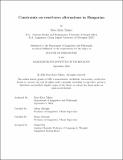| dc.contributor.advisor | Albright, Adam | |
| dc.contributor.advisor | Steriade, Donca | |
| dc.contributor.author | Takács, Dóra Kata | |
| dc.date.accessioned | 2024-12-18T18:18:19Z | |
| dc.date.available | 2024-12-18T18:18:19Z | |
| dc.date.issued | 2024-09 | |
| dc.date.submitted | 2024-12-16T20:10:30.212Z | |
| dc.identifier.uri | https://hdl.handle.net/1721.1/157881 | |
| dc.description.abstract | I analyze a large set of Hungarian nominal stems whose last vowel alternates with zero in certain contexts (Vago (1980), Siptár & Törkenczy (2000)): e.g. bokor [bokor], bokr-ok [bokr-ok]. I argue that the mechanism underlying these alternations is syncope, departing in this from earlier work (Vago (1980), Abondolo (1988), J. Jensen & Stong-Jensen (1988, 1989), Törkenczy (1995), Abrusán (2005)) which assumes epenthesis or metathesis. My research focuses on which stems fall into this closed group of vowel-zero alternating stems. I show that there is an interaction between phonological processes that repair phonotactically illicit consonant clusters – like voicing assimilation, gemination, affrication – and vowel-zero alternations. I present a proposal relying on underspecification that correctly predicts that these phonological processes block vowel-zero alternations. The grammar that generates this result includes a ranking schema where the constraint triggering syncope (referred to below as Syncope) is outranked not only by the Markedness constraints that define illicit CC-clusters in Hungarian but also by the faithfulness constraints that are normally violated in the repair of such clusters. The general ranking I will argue for is: (1) Markedness (*CC for various CCs) » Faithfulness to Cs » Syncope » Max V I also present results from a nonce word experiment, which confirms that Hungarian speakers are aware of the systematic restrictions my analysis characterizes. The broad significance of the work is to document a large-scale conspiracy (Kisseberth (1970)) whereby permissible CC clusters emerge in at least two ways: through direct action of repair processes (assimilation or merger of two Cs into one) and through blockage of the syncope process that could yield the inputs to such repairs. | |
| dc.publisher | Massachusetts Institute of Technology | |
| dc.rights | In Copyright - Educational Use Permitted | |
| dc.rights | Copyright retained by author(s) | |
| dc.rights.uri | https://rightsstatements.org/page/InC-EDU/1.0/ | |
| dc.title | Constraints on vowel-zero alternations in Hungarian | |
| dc.type | Thesis | |
| dc.description.degree | Ph.D. | |
| dc.contributor.department | Massachusetts Institute of Technology. Department of Linguistics and Philosophy | |
| mit.thesis.degree | Doctoral | |
| thesis.degree.name | Doctor of Philosophy | |
